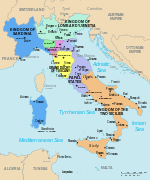
The House of Savoy is an Italian royal house that was established in 1003 in the historical Savoy region. Through gradual expansion, the family grew in power from ruling a small Alpine county north-west of Italy to absolute rule of the Kingdom of Sicily from 1713 to 1720, when they were handed the island of Sardinia, over which they would exercise direct rule from then onward.
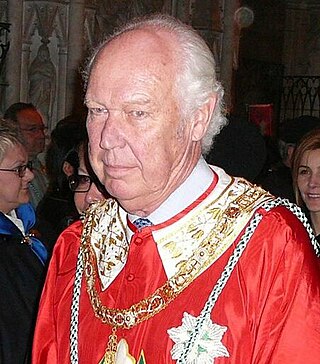
Prince Vittorio Emanuele of Savoy, Prince of Naples, was the only son of Umberto II, the last King of Italy, and Marie-José of Belgium. Vittorio Emanuele also used the title Duke of Savoy and claimed the headship of the House of Savoy. These claims were disputed by supporters of his third cousin, Prince Amedeo, Duke of Aosta, and later by Amedeo's son, Aimone.

Amadeo I, also known as Amadeus, was an Italian prince who reigned as King of Spain from 1870 to 1873. The only king of Spain to come from the House of Savoy, he was the second son of Victor Emmanuel II of Italy and was known for most of his life as the Duke of Aosta, the usual title for a second son in the Savoyard dynasty.

Prince Aimone, 4th Duke of Aosta was a prince of Italy's reigning House of Savoy and an officer of the Royal Italian Navy. The second son of Prince Emanuele Filiberto, Duke of Aosta, he was granted the title Duke of Spoleto on 22 September 1904. He inherited the title Duke of Aosta on 3 March 1942 following the death of his brother Prince Amedeo in a British prisoner of war camp in Nairobi.
A dynastic order, monarchical order, or house order is an order under royal patronage. Such an order is bestowed by, as a legitimate fons honorum, a sovereign or the head of a once-sovereign ruling family. These are often considered part of the cultural patrimony of the ruling family. Dynastic orders were often founded or maintained to reward service to a monarch or their subsequent dynasty.

The Royal Order of the Seraphim is a Swedish order of chivalry created by King Frederick I on 23 February 1748, together with the Order of the Sword and the Order of the Polar Star. The order has only one class with the dignity of Knight, and is the foremost order of Sweden.

The Royal Military Order of Saint George for the Defense of the Faith and the Immaculate Conception, also known as the Royal Bavarian House Equestrian Order of Saint George, was founded by Maximilian II Emanuel, Elector of Bavaria in 1729 to provide for a means of honouring the nobility and recognizing distinguished civil and military service.

An order of chivalry, order of knighthood, chivalric order, or equestrian order is an order of knights, typically founded during or inspired by the original Catholic military orders of the Crusades and paired with medieval concepts of ideals of chivalry.

Prince Amedeo of Savoy-Aosta, 5th Duke of Aosta was a claimant to the headship of the House of Savoy, the family which ruled Italy from 1861 to 1946. Until 7 July 2006, Amedeo was styled Duke of Aosta; on that date he declared himself Duke of Savoy, a title that was disputed between him and his third cousin, Vittorio Emanuele, Prince of Naples, only son of King Umberto II of Italy.

Emanuele Filiberto Umberto Reza Ciro René Maria di Savoia is a member of the House of Savoy. He is the son of Vittorio Emanuele of Savoy and only male-line grandson of Umberto II, the last King of Italy. In 2024, Emanuele Filberto became one of two claimants to the headship of the House of Savoy after the death of his father.

The Order of the Crown of Italy was founded as a national order in 1868 by King Vittorio Emanuele II, to commemorate the unification of Italy in 1861. It was awarded in five degrees for civilian and military merit. Today the Order of the Crown has been replaced by the Order of Merit of Savoy and is still conferred on new knights by the current head of the house of Vittorio Emanuele, Prince of Naples.

The Order of Saints Maurice and Lazarus is a Roman Catholic dynastic order of knighthood bestowed by the royal House of Savoy. It is the second-oldest order of knighthood in the world, tracing its lineage to AD 1098, and it is one of the rare orders of knighthood recognized by papal bull, in this case by Pope Gregory XIII. In that bull, Pope Gregory XIII bestowed upon Emmanuel Philibert, Duke of Savoy and his Savoy successors, the right to confer this knighthood in perpetuity. The Grand Master is, Prince Emanuele Filiberto of Savoy, Prince of Venice, also known as the Duke of Savoy, the grandson of the last King of Italy, Umberto II of Italy. However, Emanuele Filiberto's cousin twice removed Prince Aimone, Duke of Aosta claims to be grand master as his father claimed to be head of the house of Savoy.

Prince Emanuele Filiberto Vittorio Eugenio Alberto Genova Giuseppe Maria di Savoia, 2nd Duke of Aosta was an Italian general and member of the House of Savoy, as the son of Amadeo I, and was also a cousin of Victor Emmanuel III of Italy. Filiberto was also commander of the Italian Third Army during World War I, which earned him the title of the "Undefeated Duke". After the war he became a Marshal of Italy.

Vittoria Cristina Adelaide Chiara Maria di Savoia is the daughter and heir apparent to Emanuele Filiberto of Savoy, Prince of Venice, who is a claimant to the headship of the House of Savoy, the former ruling house of the Kingdom of Italy.

Prince Aimone of Savoy-Aosta, 6th Duke of Aosta is one of two claimants to be head of the House of Savoy. Since November 2019, he has served as the Ambassador of the Sovereign Military Order of Malta to Russia.

The Order of Pope Pius IX, also referred as the Pian Order, is a papal order of knighthood originally founded by Pope Pius IV in 1560. Currently, it is the highest honor conferred by the Holy See. The awarding of the order fell into disuse and was re-instituted by Pope Pius IX as a continuation on 17 June 1847.
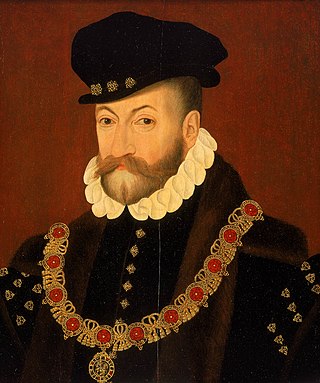
A collar, also known as collar of an order, is an ornate chain, often made of gold and enamel, and set with precious stones, which is worn about the neck as a symbol of membership in various chivalric orders. It is a particular form of the livery collar, the grandest form of the widespread phenomenon of livery in the Middle Ages and Early Modern Period. Orders which have several grades often reserve the collar for the highest grade. The links of the chain are usually composed of symbols of the order, and the badge of the order normally hangs down in front. Sometimes the badge is referred to by what is depicted on it; for instance, the badge that hangs from the chain of the Order of the Garter is referred to as "the George".
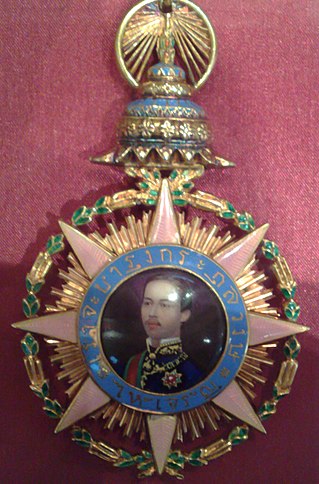
The Most Illustrious Order of Chula Chom Klao was established on 16 November 1873 by King Rama V of The Kingdom of Siam to commemorate the 90th Jubilee of the Chakri Dynasty and bears his name. The pink colour reflects the Tuesday birthday colour for King Rama V.
The Civil Order of Savoy was founded as an order of knighthood in 1831 by the King of Sardinia, Charles Albert, Duke of Savoy. It is now replaced by the Order of Merit of Savoy.The intention was to reward those virtues not belonging to the existing Military Order of Savoy, founded by Vittorio Emanuele I in 1815. The order has one degree, that of Knight, and is limited to 70 members. Admission is in the personal gift of the head of the House of Savoy.
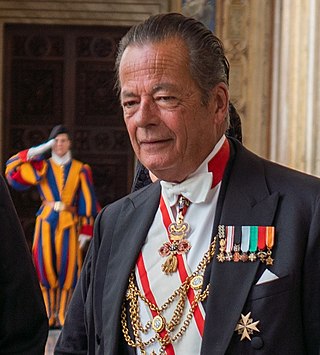
Mariano Hugo, Prince of Windisch-Graetz is the current head of the Austrian House of Windisch-Graetz. He is currently a member of the Grand Magisterium of the Equestrian Order of the Holy Sepulchre of Jerusalem. A former ambassador of the Sovereign Military Order of Malta to Slovakia, he is also currently the Order's ambassador to Slovenia. He also sits on the council of the Dynastic orders of knighthood for the Royal House of Savoy.
























